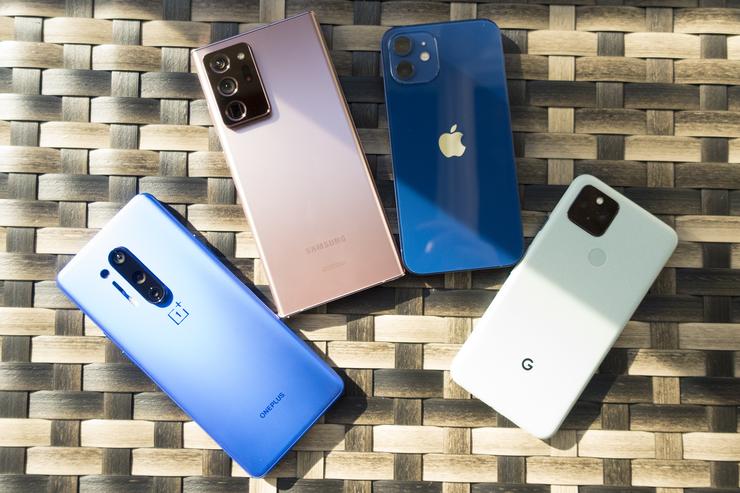 Credit: Michael Simon/IDG
Credit: Michael Simon/IDG
iPhone vs Android: Performance
The phones in this annual contest always represent the top of the line when it comes to processors and specs, and as such you’ll find the Snapdragon 865+ in the Note 29 Ultra, the 865 in the OnePlus 8 Pro, and the A14 Bionic in the iPhone 12.
But you’ll find a considerably slower chip on the Pixel 5. To keep costs down, Google has opted for the slower 765G processor, which is plenty capable but in an entirely different league. It’s not a bad chip, but it’s more akin to the Snapdragon 835 in the Pixel 2 than any of Qualcomm’s newer phone chips.
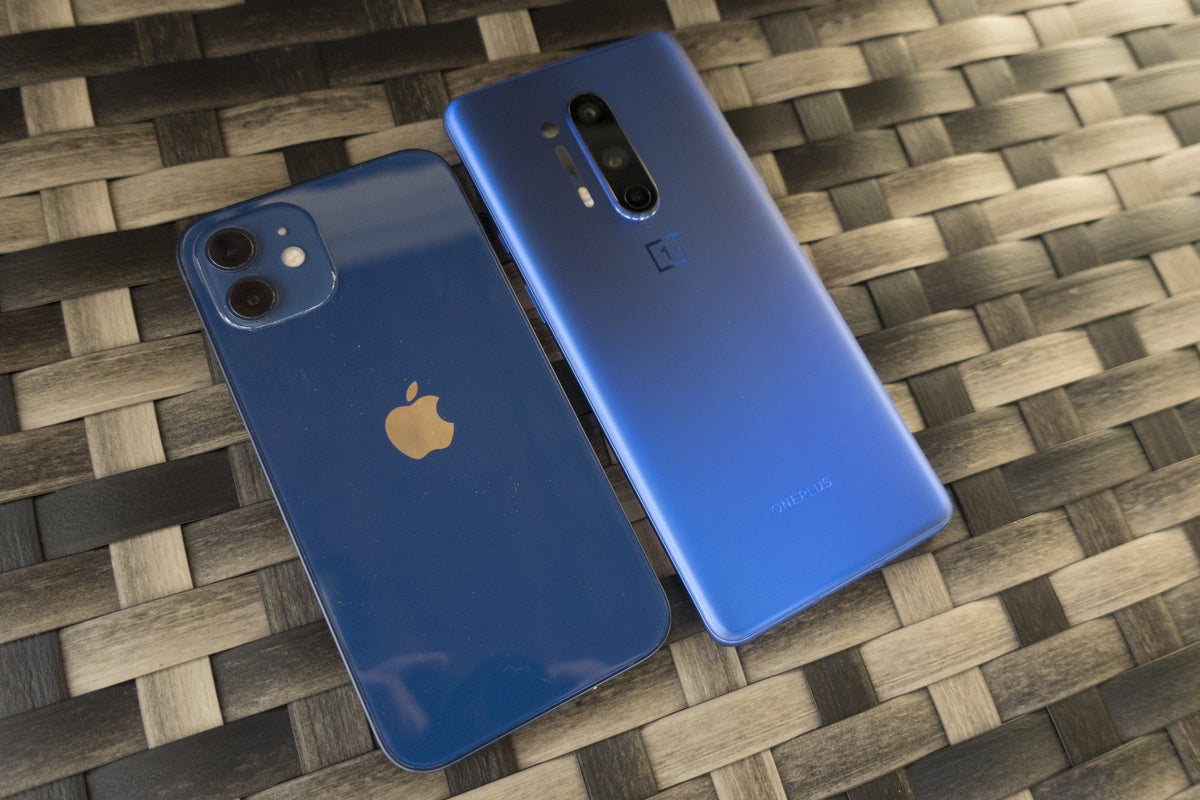 Michael Simon/IDG
Michael Simon/IDG
The iPhone 12 (left) and OnePlus 8 Pro both look beautiful in blue.
So benchmarks are going to be a little skewed. They don’t tell the whole story, as Google’s Android optimizations help a lot, but the message is pretty clear: If you want the fastest phone in 2020, the Pixel 5 isn’t it. It's the iPhone 12.
Geekbench 5 CPU Single-core/Multi-core (in order of performance)
iPhone 12: 1599/4107
Note 20 Ultra: 973/3252
OnePlus 8 Pro: 868/3165
Pixel 5: 601/1599
Geekbench 5 Compute (in order of performance)
iPhone 12: 9439
Note 20 Ultra: 3564
OnePlus 8 Pro: 3221
Pixel 5: 1010
BrowserBench Speedometer 2.0 (in order of performance)
iPhone 12: 192
Note 20 Ultra: 46.2
OnePlus 8 Pro: 72.3
Pixel 5: 26.9
You can argue all you want about the veracity of Geekbench’s results on iOS versus Android, but the fact of the matter is the iPhone 12 is head-spinningly fast. Apps fly open, scrolling is incredibly smooth even without a 120Hz display, and the system never feels sluggish in the slightest. And while I’m not sure what’s going on with the Note 20 Ultra in BrowserBench’s Speedometer 2.0 test, it doesn’t really matter when compared to the iPhone 12, which is nearly three times faster than the OnePlus 8 Pro. And somehow, the gulf is even more apparent with 3DMark’s new cross-platform Wild Life graphics benchmark.
3DMark Wild Life Unlimited (in order of performance)
iPhone 12: 8659
Note 20 Ultra: 4177
OnePlus 8 Pro: 3855
Pixel 5: 1025
The Pixel 5 might be able to get away with a lackluster chip for common tasks, but it shows its inferiority when it comes to its GPU. Once again, the iPhone is the clear winner here, with more than double the score of its closest competitor, and the real-world results bear that out. Where I experienced occasional stutter and lag with all of the other phones here, the iPhone never dropped a frame or fumbled a transition. Case in point: Wild Life measures the average frame rate on the iPhone 12 at 51fps, where the Galaxy Note 20 Ultra only reached 25fps.
 Michael Simon/IDG
Michael Simon/IDG
All shapes and sizes are represented with the phones here.
The iPhone 12 improves on boot time as well. While you’re not going to need to restart any of these phones very often, you’ll be able to start using it in no time at all. Last year, Apple brought up the rear with the iPhone 11 with a lengthy 21 seconds, the iPhone 12 nearly cuts that time in half:
Boot speed (in order of performance)
iPhone 12: 11 seconds
Pixel 5: 11 seconds
Note 20 Ultra: 13 seconds
OnePlus 8 Pro: 14 seconds
As far as 5G goes, all four phones feature sub-6GHz 5G modems on all three major networks, so if you’re in a nationwide coverage area, you’re good. If you happen to also live near one of Verizon’s super-speedy millimeter-wave hubs, you’ll be able to access it on the iPhone 12, Note 20 Ultra, and Pixel 4, which all have the required n260 and n261 bands to tap into the ultra-wideband spectrum, but not the OnePlus 8 Pro. The speeds are spectacular, but it’s not all that necessary now, when sub-6GHz 5G has only just begun to take off.
Our pick: iPhone 12
iPhone vs Android: Battery and charging
The four phones all deliver when it comes to battery life, even with vastly different capacities. Apple uses a laughably smaller capacity compared to the others here but still manages to deliver all-day battery life and then some.
Battery capacity (listed from largest to smallest)
Note 20 Ultra: 4,500mAh
OnePlus 8 Pro: 4,510mAh
Pixel 5: 4080mAh
iPhone 12: 2,815mAh
I can’t remember the last time I used an Android phone with a battery under 3,000mAh, and there’s a reason for that. If any of the ones here had a battery that small, they would almost certainly struggle to make it through half a day. But the iPhone 12 rarely finished a day with less than 20 percent remaining and somehow manages to eke more out its 2815mAh battery than Samsung or OnePlus with 4500mAh ones.
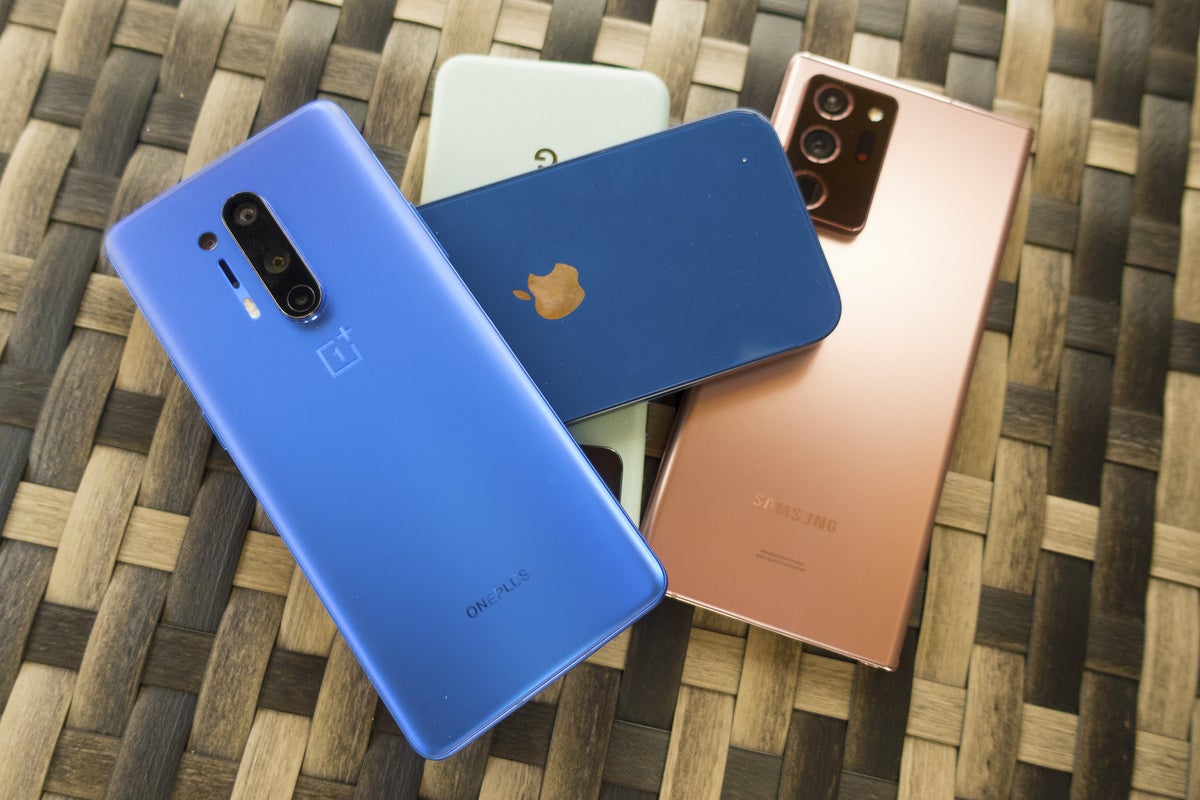 Michael Simon/IDG
Michael Simon/IDG
The colors and finishes on these phones are among the best I’ve ever seen.
Here’s how much battery was drained after playing a 1 hour, 49 minute 4K HDR movie (Birds of Prey) on each phone at full brightness and auto-brightness.
Battery loss; full brightness (listed from lowest to highest amount lost)
iPhone 12: 13%
OnePlus 8 Pro: 13%
Pixel 5: 18%
Note 20 Ultra: 19%
Battery loss; auto-brightness (listed from lowest to highest amount lost)
iPhone 12: 11%
OnePlus 8 Pro: 13%
Note 20 Ultra: 14%
Pixel 5: 16%
It’s quite remarkable. Even with such a small battery, the iPhone 12 sips power while the others drink it. All four phones are basically guaranteed to get you through the day, but the iPhone 12 and OnePlus 8 Pro are as close as you’re going to get to completely worry-free. No matter what you’re doing, neither phone will make you reach for a charge at any point throughout your day and should comfortably make it the end of it. But none of the phones here will need much in the way of charging.
 Michael Simon/IDG
Michael Simon/IDG
You’ll get USB-C on all of the phones here except the iPhone 12 (bottom), which of course has a Lightning port.
Speaking of charging, all four phones feature fast charging, but they’re quite different. For starters, the iPhone 12 doesn’t include a power adapter in the box, so you need to bring your own 20W or higher plug. The other phones all include everything you need to get peak charging out of the box.
Fast charging rate
iPhone 12: 20W
OnePlus 8 Pro: 30W
Note 20 Ultra: 25W
Pixel 5: 18W
All of the phones will fill up fast enough, but the OnePlus 8 Pro fills up the fastest without needing any extra equipment. But if you need a fast charge in less than a half-hour, any phone will fit the bill.
You’ll also get wireless charging with each of the phones and again, it varies quite a bit even when using the same standard charging pad.
Wireless charging rate
OnePlus 8 Pro: 15W
Pixel 5: 12W
Note 20 Ultra: 10W
iPhone 12: 7.5W
You’ll obviously need to bring your own charger, but the right one can actually increase your speed. OnePlus sells a Warp Charge 30W wireless charging stand that’s a little bulky and has a built-in fan for cooling, while Apple has a magnetic MagSafe charger that ups the speeds to 15W. MagSafe has the potential to be a game-changing feature and if you’re on the fence, could be the thing that pushes you over. There’s nothing like it on any Android phone and could lead to some pretty cool accessories beyond just chargers and stands.
Our pick: iPhone 12
iPhone vs Android: OS and security
I’m not about to launch into a treatise on the benefits of iOS over Android, but I’ll say this: the changes in iOS 14, particularly the App Library and home screen widgets, bring the iPhone’s customization that much closer to what you can do with Android. Apple even lets you set default browser and mail apps now.
 Michael Simon/IDG
Michael Simon/IDG
The App Library in iOS 14 (right) is very close to Android’s app drawer.
On the flip side, Android is still a bit hit or miss. While the Pixel 5 obviously ships with Android 11 out of the box and the OnePlus 8 Pro quickly received its Android 11 update, the Galaxy Note 20 Ultra is still waiting for One UI 3.0 to make it out of beta testing. Samsung hasn’t indicated when a stable release will roll out to the U.S., but it likely won’t arrive until early 2021.
The good news is the Note 20 Ultra is finally guaranteed to get updates beyond the most recent one. While Samsung’s premium phones have generally been good for two release updates and possibly a third, Samsung now assures buyers that they’ll be getting updates to their phone for years to come.
OS update cycle
Note 20 Ultra: 3 generations
Pixel 5: 3 years
OnePlus 8 Pro: 2 years
iPhone 12: Not specified
The difference between generations and years is significant. While the Note 20 Ultra released in late August, it’s only guaranteed to get Android 11, 12, and 13, even if Android 14 lands before the third year is up. Google, on the other hand, promises three years of updates, giving it a little wiggle room on phones that release on the bubble, like the 4a. At any rate, you’ll definitely get Android 14 on your Pixel 5. OnePlus continues to be extremely disappointing with updates, with its recent Nord N10 phone not guaranteed to get an update past Android 11.
The iPhone 12 might stick out, but Apple’s non-guarantee is a feature, not a bug. The iOS 14 release that just landed in September supports all iPhones going back to the 6s, which launched in 2015. Even if Apple drops support with iOS 15 as rumored, that’s five versions and six years of updates, which blows away anything you’ll get from Android.
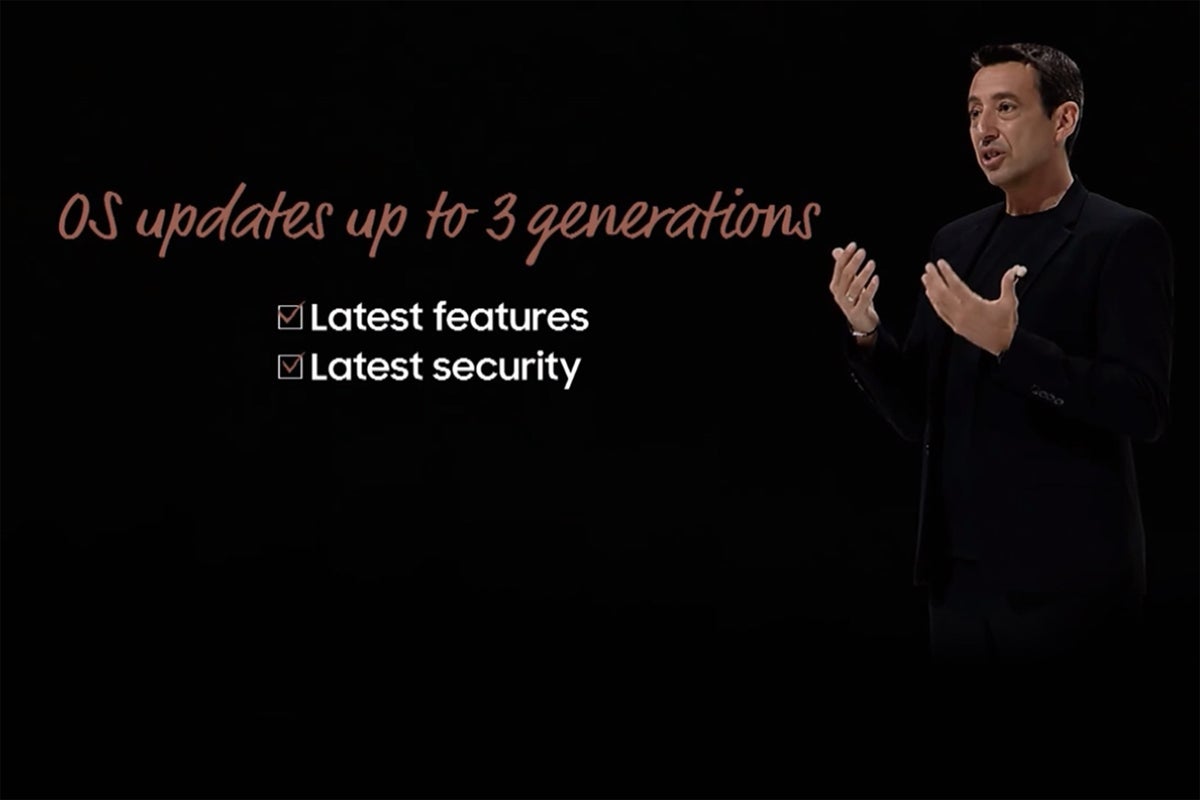 Samsung
Samsung
Samsung’s new update guarantee is kind of a big deal.
And even if you do get three full Android versions with the Note 20 Ultra, it’s likely going to be missing some features. Along with Assistant and camera features, Google has started to limit access to Android features to non-Pixel phones, including app suggestions, smarter text selection, and extreme battery saver in Android 11. They’ll arrive eventually, but with the state of updates, who knows if you’ll ever get them on your OnePlus or Galaxy phone.
Plus, Google’s Android optimizations make the Pixel experience better than any other phone here. The Pixel 5 isn’t quite on the level of the iPhone 12, especially with a far slower processor, but like Apple, Google is doing more with less on the Pixel 5. Even with a slower processor, the UI feels snappy and responsive in a way no other Android phone does.
It’s not that the OnePlus 8 Pro and Galaxy Note 20 Ultra feel slow by any stretch, but there’s something about the Pixel experience that feels natural. It’s difficult to put into words and impossible to demonstrate, but there’s a certain simpatico between the hardware and the software that make the whole thing feel pleasurable.
After this year’s moves, I’m not sure where Google’s going with the Pixel, but if it sticks with a mid-range processor, it’s going to be harder to justify phones that cost well over a thousand bucks when the Pixel performs so smoothly at a fraction of the price.
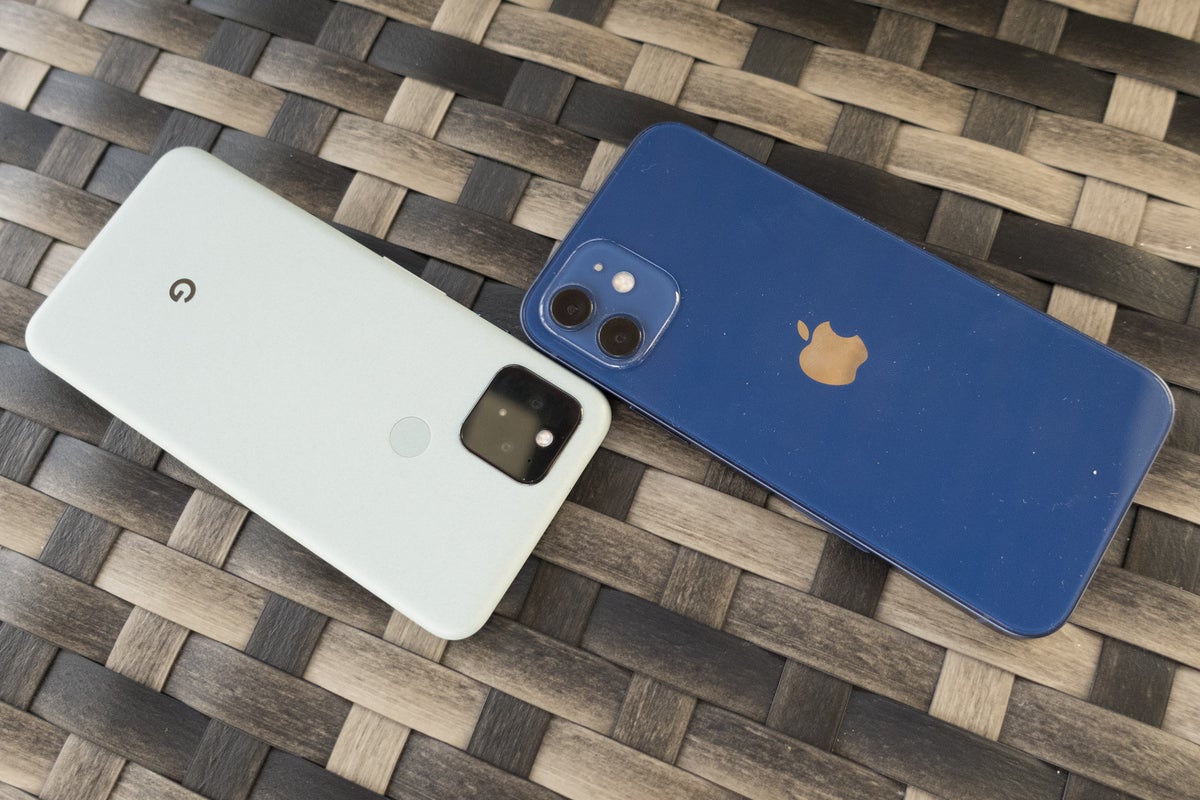 Michael Simon/IDG
Michael Simon/IDG
The Pixel 5 (left) uses an old-school fingerprint sensor.
When it comes to security, the iPhone 12 still stands alone with Face ID, its super-secure 3D face recognition biometric tech. Google tried something similar with its Soli camera on the Pixel 4, but it’s gone here (likely due to cost and lack of widespread support) in favor of an old-fashioned rear-mounted fingerprint sensor.
The Note 20 and OnePlus 8 Pro both have in-display fingerprint sensors, and while they’ve certainly improved with each release, they’re finicky and frustrating. Unlocking routinely takes several attempts, and even when it works, the method is very deliberate. With the iPhone 12, the system is much faster, more secure, and more reliable, and I even preferred the Pixel 5’s old-school fingerprint sensor to the newfangled ultrasonic and optical ones.
Our picks: iPhone 12 and Pixel 5
Next page: Camera, price, and conclusions

















